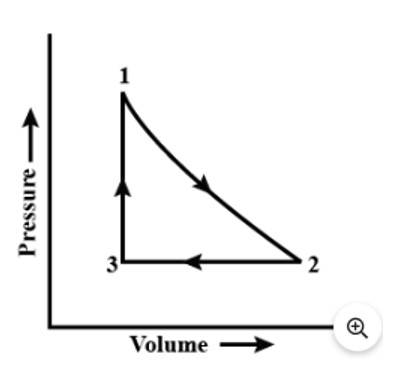Thermodynamics
Get insights from 324 questions on Thermodynamics, answered by students, alumni, and experts. You may also ask and answer any question you like about Thermodynamics
Follow Ask QuestionQuestions
Discussions
Active Users
Followers
New answer posted
3 months agoContributor-Level 10
This is a Short Answer Type Questions as classified in NCERT Exemplar
During cyclic process, change in internal energy is zero.
ΔU = 0
and no work is said to be done, as system returns to the initial state.
For a steady state cyclic process at any given stage enthalpy is one single value however, at different stage it would vary.
ΔH = 0
New answer posted
3 months agoContributor-Level 10
This is a Short Answer Type Questions as classified in NCERT Exemplar
ΔrG° = -RT ln Kp
= -RT ln (0.98)
Since In (0.98) is negative
.'. ΔrG° is positive the reaction is non spontaneous
New answer posted
3 months agoContributor-Level 10
This is a Short Answer Type Questions as classified in NCERT Exemplar
Yes, when the system and the surroundings are in thermal equilibrium, their temperatures are the same.
New answer posted
3 months agoContributor-Level 10
This is a Short Answer Type Questions as classified in NCERT Exemplar
Heat has a randomising influence on a system and temperature is the measure of average chaotic motion of particles in the system. The mathematical relation which relates these three parameters is? S = qrev/ T
Here? S = change in entropy ^
qrcv = heat of reversible reaction '
T = temperature
New answer posted
3 months agoContributor-Level 10
This is a Short Answer Type Questions as classified in NCERT Exemplar
It is a spontaneous process. Although enthalpy change is zero, randomness or disorder (ΔS) increases and ΔS is positive. Therefore, in the equation, ΔG = ΔH – TΔS, the term TΔS will be negative. Hence ΔG will be negative.
New answer posted
3 months agoContributor-Level 10
This is a Short Answer Type Questions as classified in NCERT Exemplar
In order to calculate the lattice enthalpy of NaBr,
(i) Na (s) →Na (g) ; ΔsubH? =108.4 kJ/mol
(ii) Na→Na+ + e- ΔiH? = 496kJ/ mol
(iii) Br→ Br, Δdiss H? = 96kJ/ mol
(iv) Br+e-Br- ΔegH? = - 325 kJmol-1
? fH? =? subH? + Δdiss H + Δi H? + Δi H? + Δeg H? +? lattice H?
= -360.1 -108.4-96-496+325 = -735.5KJ/ mol
New answer posted
3 months agoContributor-Level 10
This is a Short Answer Type Questions as classified in NCERT Exemplar
The reaction presented in the question is
CH4 (g)→C (g) + 4H (g)
Now, ΔaH = 1665 kJ/mol
The mean bond enthalpy of the C-H bond should be used here. For the atomisation of 4 moles of C-H bonds, the value is 1665 kJ/mol. So, per mole energy = 1665/4 = 416.2 kJ / mol
New answer posted
3 months agoContributor-Level 10
This is a Short Answer Type Questions as classified in NCERT Exemplar
According to Hess's law, ΔrH = ΔrH1+ ΔrH2+ΔrH3
This is so because during the reaction A→ B, B's formation undergoes various intermediate reactions, with the overall value of the enthalpy being ΔrH.
New answer posted
3 months agoContributor-Level 10
This is a Short Answer Type Questions as classified in NCERT Exemplar
ΔH for formation is given. For the reverse reaction, ΔHchanges sign as the reverse of exothermic reaction will be endothermic. So, ΔH for decomposition is - (-91.8)=91.8 for one mole. But here, two moles are decomposing,
ΔH=2*91.8=183.6KJ
New answer posted
3 months agoContributor-Level 10
This is a Short Answer Type Questions as classified in NCERT Exemplar
Standard molar enthalpy of formation, rH1- is just a special case of fH2-, where
one mole of a compound is formed from its constituent elements. In the above equation, enthalpy of formation and enthalpy of reaction is not the same.
Taking an Exam? Selecting a College?
Get authentic answers from experts, students and alumni that you won't find anywhere else
Sign Up on ShikshaOn Shiksha, get access to
- 65k Colleges
- 1.2k Exams
- 687k Reviews
- 1800k Answers

